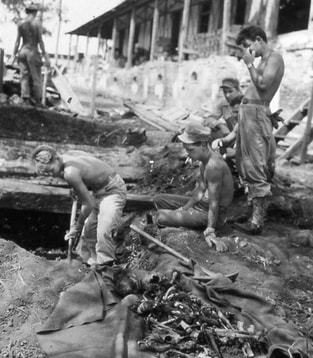This December marks the 80th anniversary of two terrible massacres. Both took place during World War II, but in different theaters of the war.
The Battle of the Bulge, which began on December 16, 1944. By the time it ended, 40 days later, approximately 600,000 American troops had participated in the largest battle ever fought by the US Army. Fighting in brutal conditions and freezing temperatures, Allied forces managed to stop the Nazi war machine from reversing the gains the Allied forces had made ever since the Normandy invasion. The Allies pushed the German Army back, but at a great price. The U.S. Army lost 19,000 men and suffered more than 80,000 casualties. 23,000 Americans were captured and taken prisoner.
One of the most horrific events within the Battle of the Bulge was the Malmedy Massacre. On December 17, 1944, roughly 80 American POWs were led to a field, where they were machine gunned to death by a Waffen-SS unit. 43 men managed to escape into the surrounding forest. Although Allied commanders started receiving news of the massacre by the evening that it occurred, the area was in German hands. Americans didn’t regain access to the area until January 13, 1945, when a Graves Registration Platoon entered the site. Because of the snow and freezing temperatures, the bodies were remarkably well-preserved, but hard to locate. An engineer platoon used metal detectors to help find them. The field was still a frontline combat area. The infantry occupied foxholes in one corner of the field, and German artillery fire repeatedly disrupted the work. Despite this, 72 bodies were found. After autopsies in a nearby abandoned railway building that had no water or electricity, the Graves Registration Platoon was able to determine by the nature of the wounds that the men were executed, rather than killed in combat. Most of the dead did not wear their mandatory identification tags. Why that was has never been determined. Despite the lack of tags, the GRREG soldiers managed to identify every single victim.
source: WikiCommons
But the massacre at Malmedy was not the only one that happened in December 1944. On the other side of the world, near the city of Puerto Princesa in the Philippine province of Palawan, another horrific event took place on December 14, 1944. It is called the Palawan massacre.
The men killed in the Palawan massacre had been interned in Palawan Prison Camp, an old Philippine Constabulary barracks since August 12, 1942, when they’d arrived in two transport ships. Originally 300 in number, the men were survivors of the Battle of Bataan and the Battle of Corregidor. For the next two years, they cleared land and constructed a concrete runway for their captors, using only hand tools, wheelbarrows and two small cement mixers. Half of the prisoners were sent back to Manila on September 22, 1944. A month later, the airstrip and nearby harbor came under allied attack and the prisoners were forced to dig trenches 5 feet deep and 4 feet wide for use as bomb shelters. Afraid that the advancing Allies would be able to rescue the prisoners of war, the Japanese sounded an air raid siren. Once the 150 men had entered the trenches, Japanese soldiers set them on fire using barrels of gasoline. Prisoners who tried to escape the flames were shot down by machine gun fire. Others attempted to escape by climbing over a cliff that ran along one side of the trenches, but were later hunted down and killed. 139 of the prisoners were killed. 11 men escaped and were aided by Filipino scouts and guerrillas.
The testimony of one survivor, Pfc. Eugene Nielsen, convinced the US military to embark on a series of rescue campaigns to save the POWs in the Philippines. The raid at Cabanatuan on January 30, 1945, the raid at Santo Tomas Internment Camp on February 3, 1945, the raid of Bilibid Prison on February 4, 1945, and raid at Los Baños on February 23, 1945 all saved POWs from horrible deaths.
Former Cabanatuan POWs in celebration.wikipedia
Jennifer Bohnhoff is a former middle grade and high school teacher who now stays home and writes historical fiction for middle grade through adult readers. She wishes to honor all who have served their country and remember those who made the ultimate sacrifice.








No comments:
Post a Comment